Akasa M.2 SSD Enclosures Reviewed: Giving Spare Drives a New Lease of Life
by Ganesh T S on September 22, 2021 8:00 AM ESTPCMark 10 Storage Bench - Real-World Access Traces
There are a number of storage benchmarks that can subject a device to artificial access traces by varying the mix of reads and writes, the access block sizes, and the queue depth / number of outstanding data requests. We saw results from two popular ones - ATTO, and CrystalDiskMark - in a previous section. More serious benchmarks, however, actually replicate access traces from real-world workloads to determine the suitability of a particular device for a particular workload. Real-world access traces may be used for simulating the behavior of computing activities that are limited by storage performance. Examples include booting an operating system or loading a particular game from the disk.
PCMark 10's storage bench (introduced in v2.1.2153) includes four storage benchmarks that use relevant real-world traces from popular applications and common tasks to fully test the performance of the latest modern drives:
- The Full System Drive Benchmark uses a wide-ranging set of real-world traces from popular applications and common tasks to fully test the performance of the fastest modern drives. It involves a total of 204 GB of write traffic.
- The Quick System Drive Benchmark is a shorter test with a smaller set of less demanding real-world traces. It subjects the device to 23 GB of writes.
- The Data Drive Benchmark is designed to test drives that are used for storing files rather than applications. These typically include NAS drives, USB sticks, memory cards, and other external storage devices. The device is subjected to 15 GB of writes.
- The Drive Performance Consistency Test is a long-running and extremely demanding test with a heavy, continuous load for expert users. In-depth reporting shows how the performance of the drive varies under different conditions. This writes more than 23 TB of data to the drive.
Despite the data drive benchmark appearing most suitable for testing direct-attached storage, we opt to run the full system drive benchmark as part of our evaluation flow. Portable flash drives are also used as boot drives and storage for Steam games. These types of use-cases are addressed only in the full system drive benchmark.
The Full System Drive Benchmark comprises of 23 different traces. For the purpose of presenting results, we classify them under five different categories:
- Boot: Replay of storage access trace recorded while booting Windows 10
- Creative: Replay of storage access traces recorded during the start up and usage of Adobe applications such as Acrobat, After Effects, Illustrator, Premiere Pro, Lightroom, and Photoshop.
- Office: Replay of storage access traces recorded during the usage of Microsoft Office applications such as Excel and Powerpoint.
- Gaming: Replay of storage access traces recorded during the start up of games such as Battlefield V, Call of Duty Black Ops 4, and Overwatch.
- File Transfers: Replay of storage access traces (Write-Only, Read-Write, and Read-Only) recorded during the transfer of data such as ISOs and photographs.
PCMark 10 also generates an overall score, bandwidth, and average latency number for quick comparison of different drives. The sub-sections in the rest of the page reference the access traces specified in the PCMark 10 Technical Guide.
Booting Windows 10
The read-write bandwidth recorded for each drive in the boo access trace is presented below.
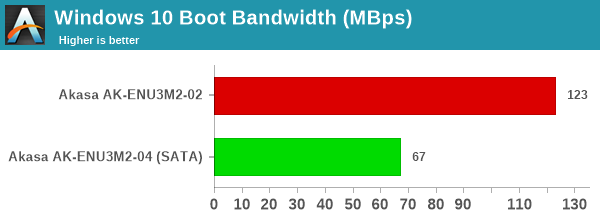
The pure SATA bridge configuration with the VIA VL716 outperforms the Realtek solution by a significant margin.

The pure NVMe bridge with the thermal solution (AK-ENU3M2-03) outperforms the Realtek solution, but the gulf is not as significant as what was seen in the SATA case.
Creative Workloads
The read-write bandwidth recorded for each drive in the sacr, saft, sill, spre, slig, sps, aft, exc, ill, ind, psh, and psl access traces are presented below.

The WD Red SA500 performs better in the AK-ENU3M2-02 (pure SATA bridge) compared to the Realtek solution (multi-protocol bridge) across all creative workloads.
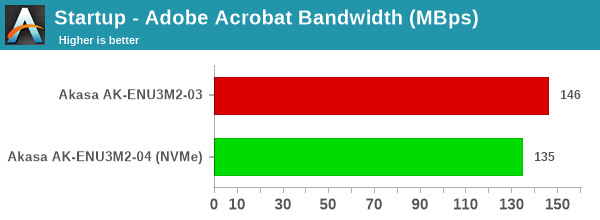
The SK hynix Gold P31 performs better in the AK-ENU3M2-03 (pure NVMe bridge) compared to the multi-protocol Realtek bridge solution across all creative workloads.
Office Workloads
The read-write bandwidth recorded for each drive in the exc and pow access traces are presented below.
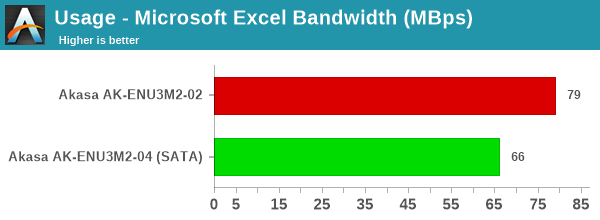
The pure bridge solution fares better for office workloads, though the difference is not as significant as what was seen in other workloads.
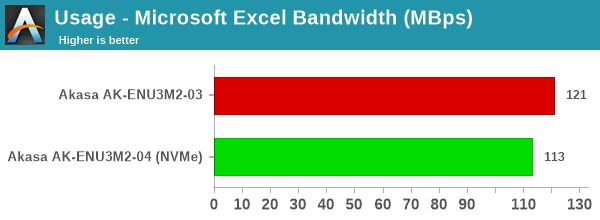
In the NVMe case too, we find the pure bridge solution faring better in the office workloads.
Gaming Workloads
The read-write bandwidth recorded for each drive in the bf, cod, and ow access traces are presented below.
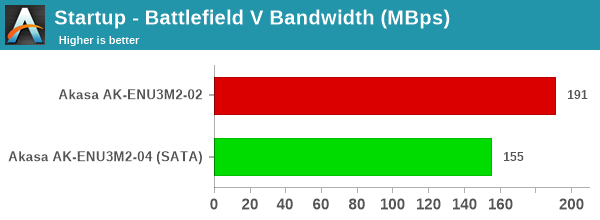
The pure bridge solution fares better for the read intensive workloads in both the SATA and NVMe cases.
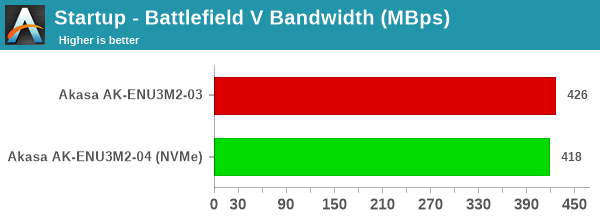
The difference between the pure and multi-protocol solution is more significant in the SATA case compared to NVMe.
Files Transfer Workloads
The read-write bandwidth recorded for each drive in the cp1, cp2, cp3, cps1, cps2, and cps3 access traces are presented below.
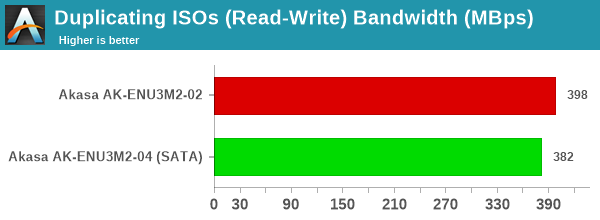
The pure SATA bridge fares better than the multi-protocol solution across the board for all file transfer workloads.
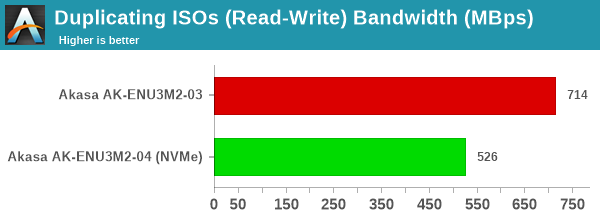
In the NVMe case, the two solutions fare similarly for pure read and pure write scenarios. However, for simultaneous reads and writes, the pure NVMe bridge solution with the ASMedia ASMM2362 outperforms the Realtek solution.
Overall Scores
PCMark 10 reports an overall score based on the observed bandwidth and access times for the full workload set. The score, bandwidth, and average access latency for each of the drives are presented below.
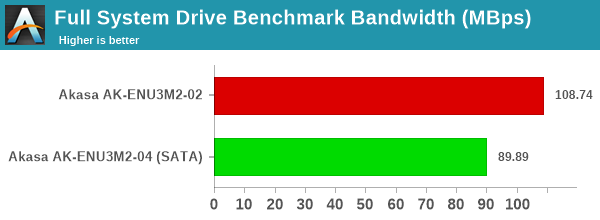
The WD Red SA500 in the pure SATA bridge solution scores 687 compared to the 550 of the multi-protocol solution.
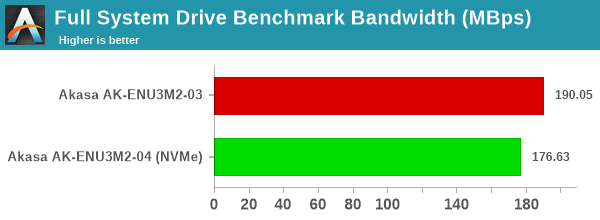
The SK hynix Gold P31 in the pure NVMe bridge solution scores 1214 compared to the 1122 of the multi-protocol solution.
Overall, we find that the multi-protocol Realtek RTL9210B-CG solution should not be preferred over pure bridge solutions when performance is important.










15 Comments
View All Comments
meacupla - Wednesday, September 22, 2021 - link
Yeah, good luck inserting an m.2 drive, with a thermal pad on it, into these tubular enclosures, while also maintaining good contact with the outer case.The_Assimilator - Saturday, September 25, 2021 - link
Almost like using high-end drives with these enclosures isn't the intended use-case (hint: it's not).dicobalt - Sunday, October 3, 2021 - link
Sabrent makes an enclosure with a removeable body that serves as a heatsink with fins. It also uses the Realtek controller.timbotim - Wednesday, September 22, 2021 - link
It's not too difficult, it just needs a bit of care and patience. Some enclosures work better than others in my experience.Oxford Guy - Wednesday, September 22, 2021 - link
It sounds like a basic design failure.Press down makes a lot more sense than slide, unless breaking the pad into chunks is supposed to improve its performance.
ballsystemlord - Wednesday, September 22, 2021 - link
The use of male ports will make it hard or impossible to use on the back of motherboards due to the cases size.ganeshts - Wednesday, September 22, 2021 - link
For the intended use-case (data backup / restore and dealing with multiple systems on a one-off basis), that is a minor price to pay for the advantage of not having to deal with different cables. I just looked up the FIDECO user reviews on Amazon, and it looks like there are plenty of computer technicians appreciating this aspect.Foufi - Thursday, September 23, 2021 - link
The Sabrent EC-SNVE also uses the Realtek RTL9210B for NVMe and SATA compatibility, but with a Type-C female port (single Type-C to Type-C cable provided). It features a sandwich design, which should provide a good contact between the thermal pad and aluminum casing and prevent throttling (haven't yet tested mine to verify the result). It is also tool free for quick installation or drive swap.The_Assimilator - Saturday, September 25, 2021 - link
So buy a female to C male USB extension cable - they're cheap as chips.BushLin - Wednesday, September 22, 2021 - link
Is my impression of Akasa out-of-date or do they still make products end up in the trash shortly after purchase?Interesting to see them feature on anandtech again so soon.